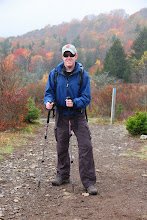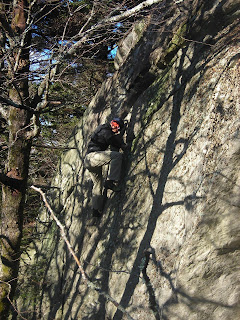External Frame Packs vs. Internal Frames
Through my work in Outdoor Retail, I am sometimes surprised by how many people still prefer the external frame over the internal frame pack. However, there's a noticeable trend, in that most of these individuals are over the age of 30. This makes a lot of sense, when you consider the external frame is the original "backpacking pack," the tried and true design. It has certainly been around the longest, and it is a solid design, even to this day. It surely appeals to a specific audience in the outdoor community; young adventurers, like the Boy Scouts, for example, are often outfitted in external frames.
 Boy Scouts are at a real disadvantage when it comes to backpacks. They are constantly growing, and, since a backpack needs to fit perfectly in order to be effective, they need a pack that can grow with them. For many years, this left children and teenagers with only one option. The external frame has the advantage of being adjustable. It can literally grow in length as the individual grows. As one might imagine, this saves a lot of money! With prices ranging from $140 to $300, who can afford to buy a new pack every other year? For a long time, there was really no question. Children should only wear external frames. But with the recent popularity of internal frames and constant advances in structure and design, young people may finally have a new option. Adjustable internal frame packs are becoming increasingly popular. Some examples I have encountered are the Kestrel line by Osprey Packs, not to mention a series of internal frames specifically for children, as well as many packs made by Deuter. Kelty, forever the king of external frames, has also jumped on the internal band wagon, and their Red Cloud series is adjustable.
Boy Scouts are at a real disadvantage when it comes to backpacks. They are constantly growing, and, since a backpack needs to fit perfectly in order to be effective, they need a pack that can grow with them. For many years, this left children and teenagers with only one option. The external frame has the advantage of being adjustable. It can literally grow in length as the individual grows. As one might imagine, this saves a lot of money! With prices ranging from $140 to $300, who can afford to buy a new pack every other year? For a long time, there was really no question. Children should only wear external frames. But with the recent popularity of internal frames and constant advances in structure and design, young people may finally have a new option. Adjustable internal frame packs are becoming increasingly popular. Some examples I have encountered are the Kestrel line by Osprey Packs, not to mention a series of internal frames specifically for children, as well as many packs made by Deuter. Kelty, forever the king of external frames, has also jumped on the internal band wagon, and their Red Cloud series is adjustable. But the question remains: why choose an internal frame over an external? Especially if one's been using an external since their days as a wee Scout.
But the question remains: why choose an internal frame over an external? Especially if one's been using an external since their days as a wee Scout.Simply put, they are better backpacks. They are far more comfortable. They offer advanced suspension, which distributes the weight of the pack more evenly across the body, easing tension, eliminating hot spots, and improving comfort and endurance. Since they are custom-fitted to the length of one's torso (measured from the top of the hip bones to the base of the neck at the C7 vertebrae) they seldom rub, slump, or teeter. Their streamlined design improves balance and hiking efficiency. As long as technology advances and the hiking community shares their concerns and wants with pack makers, the internal frame will continue to reign superior.
Well, where are the pockets? What about the ventilation factor? How can I tie all my stuff on one of those internals?
These are the main questions and concerns I hear most often. And for a long time, these were the biggest cons to crossing over. Sure, the external frame pack comes equipped with many outside pockets for stowing gear. In addition, external frames have a reputation for being well ventilated with their mesh backing and airy design. And it certainly is convenient being able to tie things to the outside of the pack. Sometimes things just don't want to fit.
 These are all great advantages. But these days, they are no longer exclusive to external frames. Many of the internal frames are now equipped with side pockets. Most will have advanced ventilation through a slight curvature of the frame. And pretty much every internal frame I've laid eyes on has several straps for tying on gear.
These are all great advantages. But these days, they are no longer exclusive to external frames. Many of the internal frames are now equipped with side pockets. Most will have advanced ventilation through a slight curvature of the frame. And pretty much every internal frame I've laid eyes on has several straps for tying on gear.But for individuals unable to invest in that super, compressible sleeping bag, the external frame may still be the best choice. In order to cross over, one must be willing to make a few extra investments. The internal frame is just that. Internal. Ninety percent of the gear must go inside the pack. The massive, jelly-roll, 0 degree bag is not going to fit, nor will the 8 pound Coleman tent. These are choices one will face if they decide to go with an internal.
But are these investments worth it? After all, a decent synthetic or down sleeping bag could range anywhere from $100 to $250. And light and compact tents are not cheap either. Take it from someone who has been there. I made the crossover just a year ago, and it has been so worth it. I am able to hike faster, cover more ground, experience more on every trip, and I'm comfortable from the moment I put the pack on to the moment I take it off at the end of the day. And in my experience, the individuals who seem to most appreciate the comfort and support of internal frames are those who have only ever known the dependability (yet, discomfort) of externals, but finally went out on a limb and decided to give it a try.
































